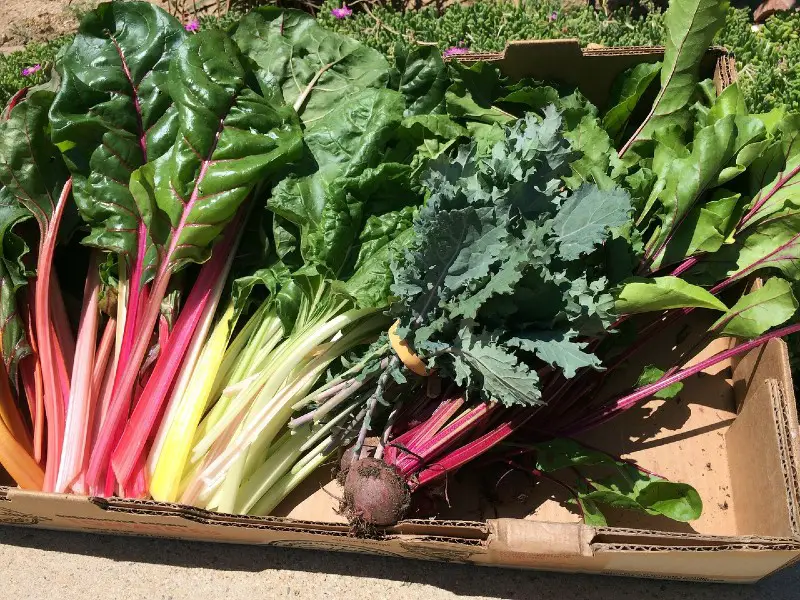Cooking Hacks: Easy and Delicious Substitutes for Swiss Chard!
Swiss chard, a leafy green vegetable packed with vitamins and nutrients, has a unique flavor and texture that brings depth and character to many recipes. Its earthy flavor, tender leaves, and crunchy stalks make it a popular ingredient suitable for both raw and cooked applications.
Importance of Finding Substitutes
While Swiss chard is a great and delicious ingredient, it may not always be readily available or suitable for everyone’s tastes. Therefore, discovering suitable substitutes becomes essential, allowing cooks and food enthusiasts to maintain the integrity of their recipes and still enjoy delightful flavors and textures. This is where knowing suitable substitutes can be beneficial.
Understanding Swiss Chard
Characteristics and Flavor Profile
Swiss chard is known for its earthy flavor, often described as a cross between beet and spinach. It carries a mild bitterness, which can mellow out when cooked, leaving a sweet aftertaste. The white-stalked Swiss chard is generally milder in flavor compared to its red and rainbow counterparts, which tend to have a slightly more pronounced earthy and beet-like flavor.
The Unique Texture of Swiss Chard Leaves and Stems
The texture of Swiss chard can be divided into two components: the leaves and the stems. The leaves of Swiss chard are tender and somewhat similar to spinach, but with a more substantial texture. They wilt under heat but can hold up to a variety of cooking methods.
The stalks, on the other hand, offer a crunchy texture akin to celery but with a sweeter taste. They are thicker and require a longer cooking time compared to the leaves.
Nutritional Value and Health Benefits
Swiss chard is a nutritional powerhouse, delivering an abundance of vitamins and minerals. It is an excellent source of vitamin K, essential for bone health and blood clotting. Additionally, it provides vitamins A and C, contributing to healthy skin and immune function. The iron content supports red blood cell production, while magnesium aids in muscle and nerve function.
Culinary Uses and Common Recipes
In the culinary world, Swiss chard is widely cherished for its versatility. It can be enjoyed raw in salads, adding a refreshing element to greens mixes. When cooked, the leaves wilt down, becoming tender and delicious.
Swiss chard can be sautéed, steamed, braised, or used as a flavorful ingredient in soups, stews, and casseroles. Its stems are edible too and can be pickled or stir-fried for a delightful crunch.
Overall, Swiss chard elevates the taste and nutrition of a variety of dishes, making it a beloved choice in many cuisines worldwide.
Factors to Consider When Choosing Substitutes
A. Flavor Profile
When selecting substitutes for Swiss chard, it is crucial to consider the flavor profile of the alternative greens. Look for options that share similar earthy and slightly bitter notes to maintain the intended taste of your recipes.
B. Texture and Appearance
Pay attention to the texture and appearance of the substitute greens. Aim for leaves that are tender yet not too delicate, ensuring they can withstand various cooking methods without turning mushy.
C. Nutritional Content
Ensure the substitute greens offer comparable nutritional value to Swiss chard. Seek alternatives rich in vitamins, minerals, and other essential nutrients to maintain the health benefits of your dishes.
D. Cooking Methods
Consider how the substitute greens behave when cooked. Some greens may wilt quickly, while others retain their structure. Pick substitutes that align with your desired cooking techniques to achieve the desired results in your recipes.
Leafy Green Swiss Chard Substitutes
Spinach
Spinach, a highly versatile leafy green, is one of the most common substitutes for Swiss chard. With a mild and slightly sweet taste, spinach shares some of Swiss chard’s flavor profile. While it’s less earthy, spinach can effectively carry the flavors of the dish, just like Swiss chard.
The texture of spinach, however, varies slightly from Swiss chard. Spinach leaves are smoother and tend to wilt more quickly during cooking, resulting in a more delicate texture.
In raw salads or in recipes that require a quick sauté, spinach is an excellent replacement for Swiss chard. However, in dishes that require a longer cooking time, it’s important to add spinach towards the end of the cooking process to prevent overcooking and losing its texture.
Kale
Kale is another suitable alternative for Swiss chard, especially in cooked dishes. Kale’s flavor is more robust and earthy than that of Swiss chard and spinach, with a slight peppery kick. This makes it a great substitute when the dish requires a more pronounced leafy green flavor.
In terms of texture, kale is considerably tougher and coarser than Swiss chard. It holds up well to cooking, making it a good choice for soups, stews, and stir-fries where the greens need to retain some crunch. However, for raw dishes, it’s recommended to massage kale leaves with a bit of oil to tenderize them before using.
Mustard Greens
Mustard greens offer a unique, peppery, and slightly bitter flavor that can be a nice change from Swiss chard’s earthiness. They are an excellent substitute when a recipe calls for a leafy green with a little more spice.
Mustard greens have a similar texture to Swiss chard, with large, rough leaves that soften when cooked. They are excellent in stir-fries, soups, and stews, but keep in mind their strong flavor profile when using them as an alternative. For raw salads, young and tender mustard greens are preferable as they’re less bitter and more tender.
Turnip Greens
Turnip greens are known for their slightly bitter, peppery taste. This sharpness can add depth to various dishes, especially those with rich ingredients that can balance the bitterness. If the recipe can handle a stronger, more assertive leafy green, then turnip greens can be an excellent substitute.
In terms of texture, turnip greens are similar to Swiss chard. They have hearty leaves that can hold up to a variety of cooking methods, from sautéing to braising. Raw, they tend to be a bit tough, so they’re often enjoyed cooked, which softens them and mellows out their bitterness.
Just like Swiss chard, turnip greens are nutritionally dense, packed with vitamins A, C, and K, and are a good source of fiber. Therefore, using turnip greens not only replicates the texture of Swiss chard but also preserves the nutritional integrity of your dish.
Stalk Substitutes for Swiss Chard
Celery
When a recipe primarily calls for the crunchy stalks of Swiss chard, celery can be a suitable alternative. With its distinctly fresh, crisp texture, celery brings a comparable crunch to dishes. However, it’s important to note that the flavor of celery is different from Swiss chard’s stalks. It has a more pronounced, slightly bitter, and fresh taste.
Celery stalks work well in soups, stews, stir-fries, or any dish where Swiss chard stalks are called for. They can also be used raw in salads, providing a delightful crunch. When substituting with celery, it may be necessary to adjust seasoning to balance the stronger flavor of celery.
Bok Choy
Bok choy, also known as Chinese cabbage, is another excellent substitute for Swiss chard stalks. The white parts of bok choy closely mimic the crisp texture of Swiss chard stalks. They’re mildly flavored, somewhat sweet, and absorb flavors of the dish well, similar to Swiss chard stalks.
Bok choy can be used in a variety of cooking methods including stir-frying, steaming, and braising. The green leafy part is tender and cooks more quickly, so it’s best to add them towards the end of the cooking process. Bok choy is especially suitable in Asian-inspired recipes, but its mild flavor makes it a great replacement in many dishes that call for Swiss chard.
Comprehensive Alternatives (Both Leaves and Stalks)
Collard Greens
If you’re looking for a replacement that matches both the leafy and stalk aspects of Swiss chard, collard greens may be an ideal option. These robust, slightly bitter greens can be a stand-in for Swiss chard in many recipes, especially those that involve cooking or sautéing.
The taste of collard greens can be a bit more bitter and earthy than Swiss chard, but this can add depth to a variety of dishes. In terms of texture, collard greens have sturdy leaves and a thick, edible stem that is similar to Swiss chard’s stalks. When using collard greens as a substitute, it’s crucial to remember they require a longer cooking time to reach the desired tenderness.
Beet Greens
Beet greens, often discarded or overlooked, are in fact a great substitute for Swiss chard. The taste profile is incredibly similar, as both Swiss chard and beet greens belong to the same family. Beet greens are slightly sweeter and have a taste profile similar to spinach, coupled with the earthy undertone of beets.
Like Swiss chard, beet greens come with both leafy parts and stalks, and both are edible. The stalks are a bit more fibrous than Swiss chard’s, so they may require longer cooking. Beet greens can be used in the same way as Swiss chard, in sautés, soups, and stews, or they can be eaten raw in salads. Next time you have fresh beets with the greens still attached, think twice before discarding the tops!
Vegan and Vegetarian Substitutes
Plant-Based Alternatives to Swiss Chard: For vegans and vegetarians, several plant-based options can replace Swiss chard. Consider using spinach, kale, collard greens, or beet greens in your recipes for similar nutritional benefits.
Using Tofu, Tempeh, and Seitan: To add a protein boost to your dishes, incorporate tofu, tempeh, or seitan along with the substitute greens. These plant-based protein sources complement the flavors and textures of the greens, creating satisfying and wholesome meals.
Combining Substitutes for Creative Recipes
Flavor Pairings and Complementing Ingredients: Experiment with flavor pairings to enhance the taste of your dishes. Combine substitutes with ingredients like garlic, lemon, nuts, and dried fruits to add depth and complexity to your recipes.
Texture Combinations for Balance: Balance the textures of your dishes by mixing different substitutes. Combine tender greens with crunchy stems or add a mix of wilted and fresh leaves to create a delightful texture contrast.
Substituting Swiss Chard in Specific Dishes
A. Soups and Stews: Swap Swiss chard with kale or collard greens in hearty soups and stews for a robust and nutritious addition to your comforting dishes.
B. Salads and Side Dishes: Choose spinach or beet greens as substitutes in salads and side dishes, adding color and flavor to your meal spreads.
C. Stir-Fries and Sautéed Dishes: Experiment with bok choy or mustard greens in stir-fries and sautéed dishes, creating a delightful Asian-inspired twist to your meals.
D. Casseroles and Gratin: Incorporate turnip greens or Swiss chard stems into casseroles and gratin recipes, providing interesting textures and flavors to your baked dishes.
Tips for Cooking with Substitutes
Adjusting Cooking Times and Techniques
Be mindful of the cooking times and techniques required for each substitute. Some greens cook faster than others, so adapt your cooking methods accordingly.
Proper Seasoning for Enhancing Flavor
Experiment with different seasonings and herbs to enhance the flavor of the substitutes. Adjust the seasonings to complement the specific taste profile of each green.
Avoiding Overcooking
To retain the nutritional value and texture of the substitutes, avoid overcooking. Cook the greens until they are just tender and vibrant to preserve their goodness.
Conclusion
Using substitutes like spinach, kale, collard greens, and beet greens provides an excellent alternative to Swiss chard. These greens offer a diverse range of flavors, textures, and nutritional benefits, making them valuable additions to your culinary repertoire.


